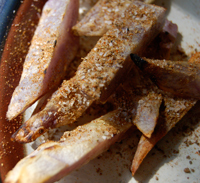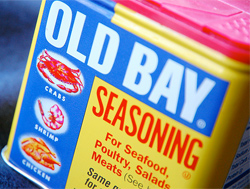I’m serious. Don’t even bother.
I wholeheartedly encourage you to whip up your own crab seasoning or make your own Cajun spice. Sprinkle these mixes liberally everywhere you would use Old Bay — seafood, corn on the cob, french fries, wherever. But when you do this, start with the intention of making something different from Old Bay. Trying to beat Old Bay is a losing proposition. There are many reasons why. Here are the top three:
1) Old Bay is pretty good already.
2) If you don’t already own them, buying all of the spices that go into Old Bay will cost you $50 or so, just to create a product that you can buy, ready-made, for under $5.
3) If you try to call anything that doesn’t come in that classic, primary-colored tin “Old Bay,” a roving gang of ardent Old Bay supporters (most likely from the Chesapeake Bay area) will hunt you down and force-feed you crabs until you show some respect for their illustrious hometown spice.
Seriously: Old Bay was created by a German immigrant in Baltimore in 1939 (and originally named Delicious Brand Shrimp and Crab Seasoning). Seventy years later, Marylanders remain fiercely devoted to the stuff. Ben Adler, a writer for Washington-based Internet Food Association, knows this all too well. After a trip to a D.C.-area crab joint earlier this summer Adler, a native New Yorker, complained about “Old Bay, a local Mrs. Dash-like seasoning that Marylanders inexplicably put on all kinds of things.” The comments that followed served to school Adler, noting everything from the fact that “the savory and slightly spicy taste of Old Bay seasoning is a perfect compliment to the natural crab flavors” to the straightforward “you are a jackass.”
Another person who made mention of Adler’s tirade was Brian Wolly. In a response on the Smithsonian’s Food & Think blog, Wolly used an important word: nostalgia. Nostalgia — especially regional nostalgia — is a powerful and strange tool in the world of edibles. It can lead a vegetarian to defend a local burger, or a raw foodist to celebrate a hyperlocal potato chip. Moreover, this emotional connection to a food acts as a strong filter for any new yet similar food.
Think of it this way: Everyone knows that “the book is better than the movie,” but if you see the movie first and love it fiercely, it’s hard to like the book better. Take The Shining. You might enjoy the book and be able to logically say that it’s better than the film, but if you’re fiercely attached to Jack Nicholson’s wild eyes and Shelley Duvall’s terror, you’ll forever be seeing the book’s characters filtered through them. Similarly, if you really like Old Bay, any Cajuny crab spice you try will be tasted through that lens: you might be able to respect the new spice, and you might even like the new spice, but it’s never going to be Old Bay.
I, unfortunately, learned this first-hand. When I was testing spice mixes for this column, I made the mistake of putting my mix directly up against Old Bay, serving two spiced piles of fries to acquaintances. “This one is Old Bay,” noted one taster who then pointed to the pile with my mix and said, “and this one tastes like fake Old Bay.” Now I don’t want the aforementioned Old Bay gang to come beat down my door and complain that I’m whining because my spice mix isn’t as good as Old Bay. I am fully admitting my stupidity: I never should have put my spice mix in direct contact. This was confirmed later when I served my version again, this time on grilled potatoes, without Old Bay for comparison. People really enjoyed it. I didn’t mention OB, and neither did they.
So, lesson learned — if you’re going to mess with a nostalgic food’s success, don’t compare it. Don’t mention it. Just serve it. It’ll be good. And I swear, Old Bay gang, I’m not trying to front on your spice, but you’re welcome to show up at my house and force-feed me crabs any time you like. • 24 September 2009
| Not Old Bay |
 When working on this recipe, I first tried two different recipes that claimed to be homemade versions of Old Bay – one from About.com, and one from the Chowhound forums. Both had the same basic ingredients, and both shared the same flaw: calling for an insane amount of ground bay leaf that overpowered the entire recipe, as if the name “Old Bay” came from the leaf and not from a Chesapeake Bay steamship line. After playing with several versions, I finally came across the mix below. It has a sweet sort of flavor that traditional Old Bay does not thanks to increased quantities of cinnamon, allspice, cloves, and nutmeg. When working on this recipe, I first tried two different recipes that claimed to be homemade versions of Old Bay – one from About.com, and one from the Chowhound forums. Both had the same basic ingredients, and both shared the same flaw: calling for an insane amount of ground bay leaf that overpowered the entire recipe, as if the name “Old Bay” came from the leaf and not from a Chesapeake Bay steamship line. After playing with several versions, I finally came across the mix below. It has a sweet sort of flavor that traditional Old Bay does not thanks to increased quantities of cinnamon, allspice, cloves, and nutmeg.
1 Tablespoon salt Mix all ingredients. Store in an air-tight container. |




